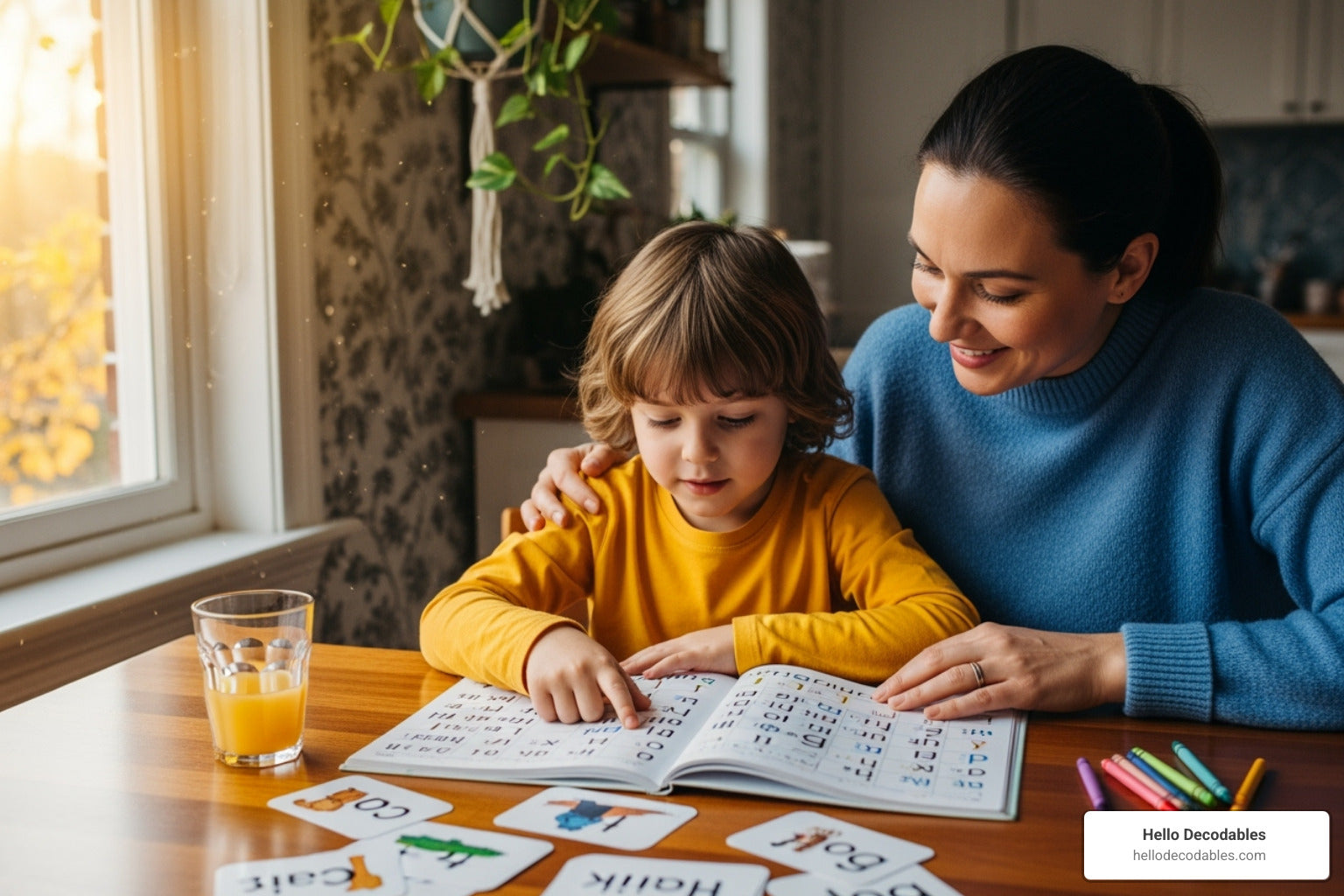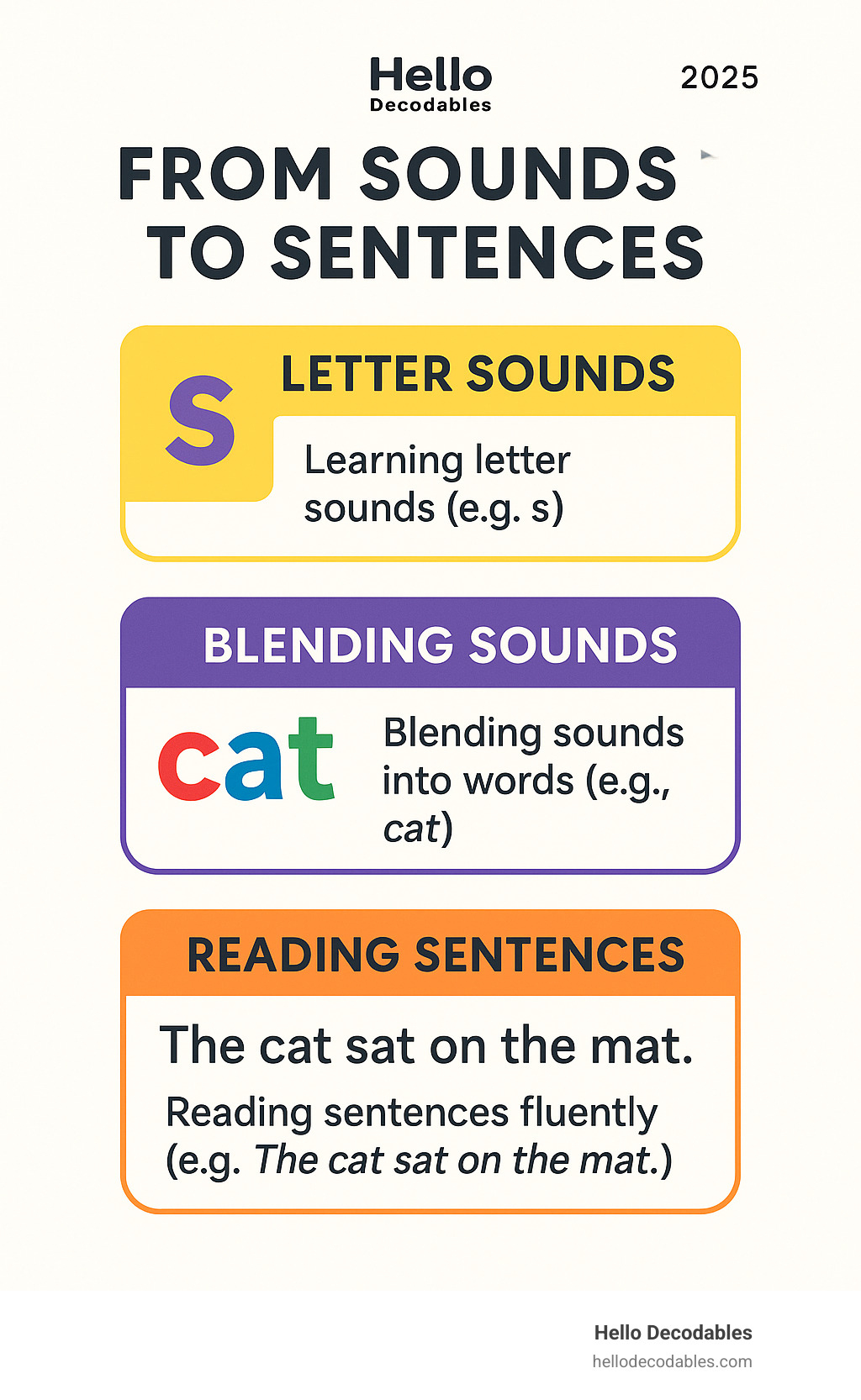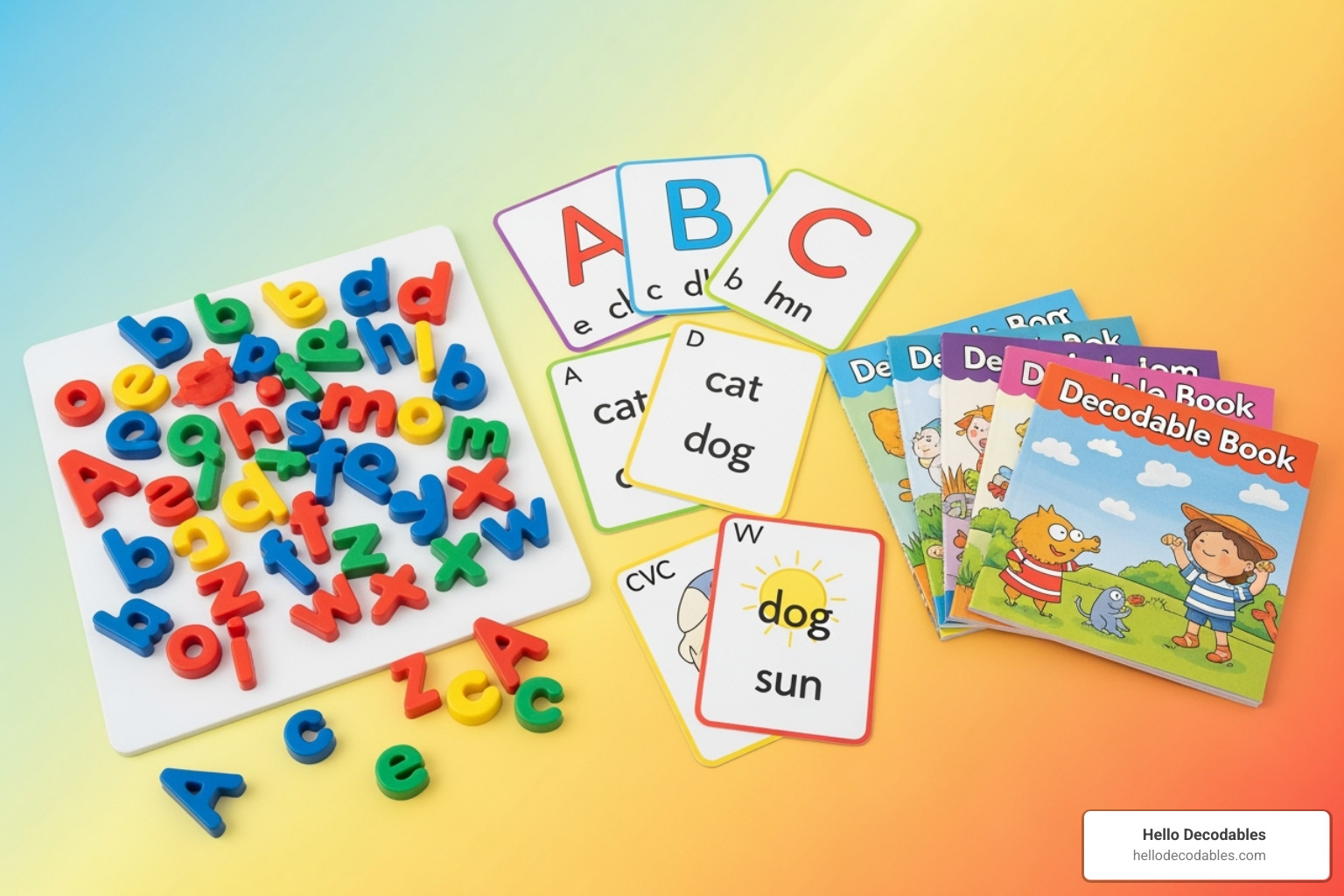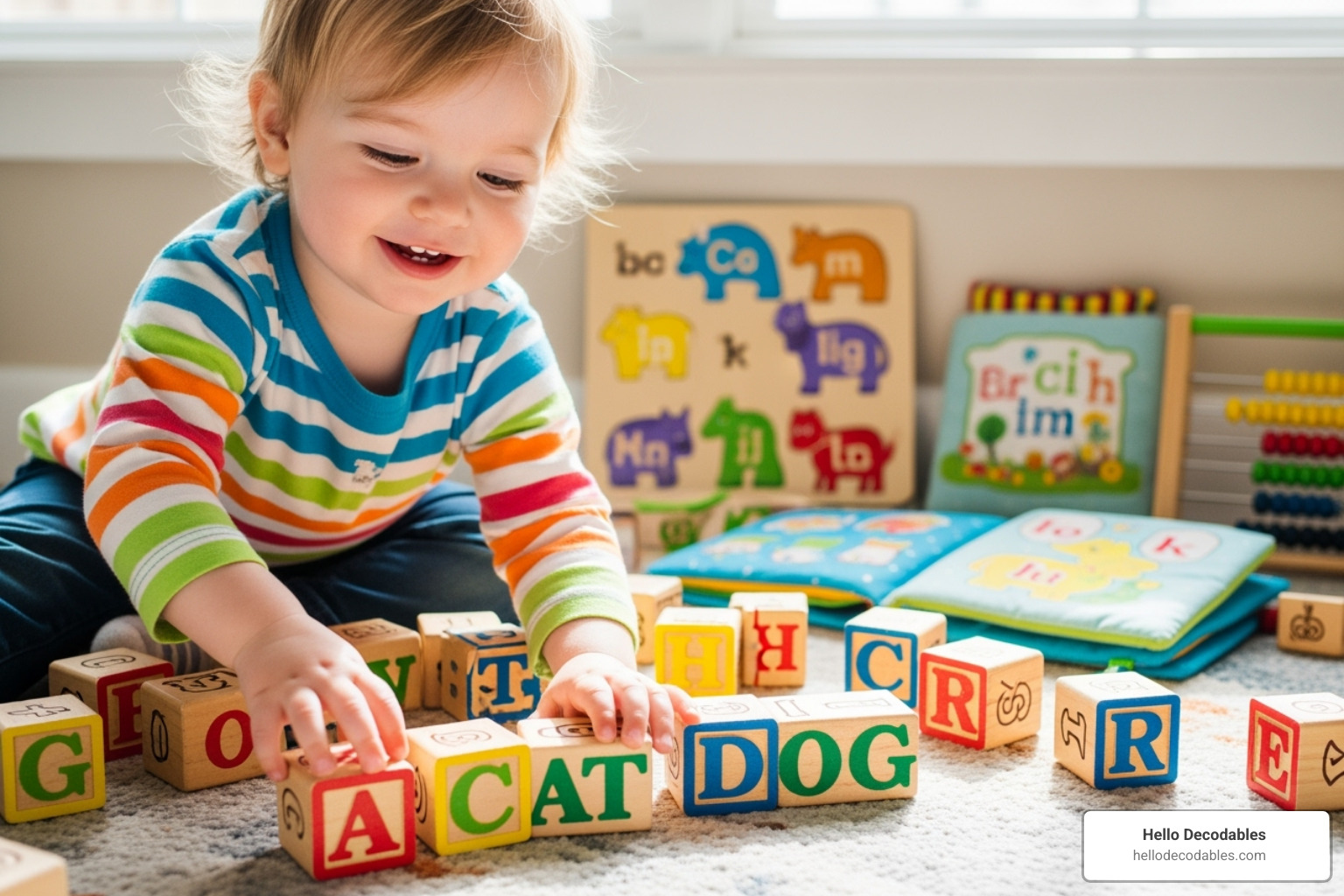
· By Jen Jones
Phonics at Home: Your Guide to Raising a Reader
Why At Home Phonics Makes All the Difference
At home phonics practice is a powerful way to help your child become a confident reader. Research shows that 20 minutes a day can close the reading gap for 75% of struggling readers, yet many fourth graders still read below proficient levels.
Quick Start Guide for At Home Phonics:
- Start with letter sounds - Focus on the sound each letter makes, not its name.
- Practice blending - Help your child connect sounds (c-a-t = "cat").
- Use decodable books - Choose books with words your child can sound out.
- Make it fun - Turn practice into games like sound scavenger hunts.
- Keep it short - 15-20 minutes of focused practice is best.
- Connect with school - Ask the teacher which phonics skills to focus on.
Phonics teaches the relationship between sounds (phonemes) and letters (graphemes). When children master these letter-sound relationships, they can decode unfamiliar words independently. This builds a strong foundation for reading comprehension and the confidence every young reader needs.
Effective phonics instruction is systematic and explicit, but it doesn't have to be stressful. Phonics work at home should last no longer than 5 minutes.
You can also download some letter cards from the Freebie section of my website.
I'm Jen Jones, a literacy expert with over 30 years in education and founder of Hello Decodables. Throughout my career, I've seen how at home phonics practice transforms struggling readers into confident ones. The key is knowing what to do and making it enjoyable for you and your child.

Understanding the Phonics Journey: From Sounds to Sentences
Watching your child learn to read is rewarding. Behind the magic of sounds clicking into words is a structured process called phonics. Understanding this journey helps you become your child's most effective reading partner.
At home phonics support is most effective when it aligns with classroom instruction. Phonics follows the alphabetic principle: the idea that letters represent sounds in spoken language. This gives children a reliable system for tackling new words.
The most effective instruction is rooted in the Science of Reading, which shows that systematic instruction works best. We teach sounds and letters in a logical sequence, from simple to complex. Understanding this progression helps you support your child's learning. For a deeper dive, see The ABCs of Phonics: What Every Parent and Educator Should Know.
What are the Key Stages of Phonics Learning?
Most phonics programs follow a similar progression. Understanding these phases helps you tailor your at home phonics practice to your child's current needs.
| Phase | Focus/Skills Developed | Example Words/Sounds |
|---|---|---|
| Phase 1: Auditory/Phonological Skills | Developing listening skills, sound discrimination, rhythm, rhyme, alliteration, oral blending, and segmenting. This phase doesn't involve letters yet. | Environmental sounds, animal noises, rhyming songs, "I spy with my little eye, something beginning with /m/." |
| Phase 2: Basic Letter Sounds | Introducing the first 19 letter sounds and their corresponding graphemes (letters). Children learn to blend sounds to read simple words (CV, CVC) and segment words for spelling. | s, a, t, p, i, n, m, d, g, o, c, k, e, u, r, h, b, f, l. Words like: sat, pin, dog, cat, sun. |
| Phase 3: Digraphs/Trigraphs | Introducing the remaining 7 single letter sounds (j, v, w, x, y, z, qu) and common digraphs (two letters, one sound) and trigraphs (three letters, one sound). Children learn to read and spell words containing these new graphemes. | ch, sh, th, ng, ai, ee, igh, oa, oo, ar, or, ur, ow, oi, ear, air, ure, er. Words like: chip, sheep, moon, boat, chair, light. |
| Phase 4: Consonant Blends | No new sounds are introduced. The focus is on blending and segmenting words with consonant clusters (e.g., CCVC, CVCC, CCVCC words), building fluency and automaticity. | Words like: clap, frog, milk, hand, trust, splash, spring. |
| Phase 5: Alternative Spellings | Introducing alternative spellings for sounds already learned (e.g., 'ay' for /ai/, 'a-e' for /ai/) and alternative pronunciations for graphemes (e.g., 'ea' in 'team' vs. 'head'). Children learn to read more complex words and begin to use split digraphs (magic 'e'). | /ai/ spelled: ai, ay, a-e. /ee/ spelled: ee, ea, e-e, ey, y. /igh/ spelled: igh, ie, i-e, y. /oa/ spelled: oa, ow, o-e. Words like: play, make, treat, these, bike, home. |
| Phase 6: Developing Fluency & Comprehension | Focus on developing reading fluency, comprehension, spelling strategies, and understanding morphology (prefixes, suffixes). Children apply phonics knowledge to read longer, multi-syllabic words and become more confident, independent readers. | Learning rules for adding suffixes (-ing, -ed, -er), understanding root words. Reading multi-syllabic words like: fantastic, beautiful, elephant. |
Phase 1 is auditory. Children develop listening skills through songs and rhymes, which are foundational.
Phase 2 is when first reading happens. Children learn their first letter sounds and blend them into words.
Phase 3 introduces letter combinations like "sh" and "ch," where two letters make one sound.
Phase 4 focuses on fluency. Children practice reading words with consonant blends to build speed and confidence.
Phase 5 introduces different ways to spell the same sound, opening up a huge number of new words.
Phase 6 is the goal: fluent readers who can tackle complex texts and understand what they read.
How to Sync Up with Your Child's School
Successful at home phonics practice aligns with classroom learning. Strong parent-teacher communication is key.
Ask your child's teacher for their phonics scope and sequence—the order they teach skills. Knowing their approach, whether it's a program like Jolly Phonics or another systematic method found on sites like Reading Rockets, helps you stay consistent.
Ask questions like: "What phonics patterns is my child working on this week?" and "Which sight words should we practice?" Teachers appreciate parents who want to reinforce classroom learning. They can suggest activities or decodable books that match your child's level.
Your role is to provide practice and encouragement. When home and school work together, children make faster progress and feel more confident.
The Essential Toolkit for At Home Phonics
An effective at home phonics environment uses simple tools: magnetic letters, flashcards, and decodable books that match your child's phonics level. Use my free Quick Placement Assessment to know your child's phonics skill level.
Once you know their phonics skill level, you can purchase decodable books on my site as well. The accompanying lessons will also teach your child how to spell the phonics patterns they are learning to read.

Create a reading-rich environment where books are accessible and reading feels natural. A cozy reading corner, books in the car, or simply seeing you read can make a big difference.
The key is consistency over intensity. A focused 15-minute session daily is better than a stressful hour once a week. Short, regular practice keeps children engaged and is easier for busy families to maintain. For more strategies, explore Mastering Reading with Phonics: Tips and Strategies.
The Power of Decodable Books
Not all children's books are ideal for phonics practice. Decodable books are designed with a high percentage of words that align with the phonics skills your child has learned. For example, if they know 'c', 'a', and 't', they'll read words like "cat" and "mat," not irregular words like "yacht."
This builds confidence. When children can successfully decode most words on a page, they feel capable and motivated. It's like using training wheels on a bike—they practice real skills in a supportive setting.
Decodable books allow children to apply their phonics knowledge in the context of a story, reinforcing letter-sound relationships. Learn more in The ABCs of Decodable Books: What Makes Them Essential.
Tackling Sight Words (and Why They're Different)
Another piece of the puzzle is sight words. These are high-frequency words like "the," "was," and "said" that often don't follow phonetic rules and must be memorized.
Sight words work with phonics to build fluency. Recognizing common words instantly frees up mental energy for decoding trickier words and understanding the story.
How Much Practice Is Enough?
Depending on your child's age and grade, the 20 minutes a day recommendation is backed by research showing it can close the reading gap for most struggling readers. This time can be broken up.
For young children, try "bite-sized" sessions: 5 minutes of letter sounds here, 10 minutes with a decodable book there. Short bursts prevent frustration.
Make it a routine. Consistency helps phonics practice feel like a natural part of the day, not a chore. This builds essential skills and a love for reading. For more guidance, see Effective Phonics Lessons: How Much Time Is Just Right?.
10 Fun and Easy Phonics Activities to Try Today
The secret to successful at home phonics is making it feel like play. When children are engaged and having fun, they absorb information. Multi-sensory activities—involving sight, hearing, and touch—are powerful for cementing letter-sound connections.
Phonics practice can happen anywhere, anytime. Weave it into your daily routine while cooking, driving, or on a rainy day. For more teaching approaches, explore From Sounds to Words: A Beginner's Guide to Teaching Phonics.

10 Fun Phonics Activities
- Letter Sound Scavenger Hunt: Pick a target sound (like /m/) and hunt for objects around the house that start with that sound. This connects abstract sounds to concrete objects.
- Magnetic Letter Word Building: Use magnetic letters on the fridge to build simple CVC words like "cat" or "sun." Change one letter to make a new word ("cat" to "hat") to show how sounds create words.
- Shaving Cream or Sand Writing: Spread shaving cream or sand in a tray. Have your child trace letters and words with their finger while saying the sounds aloud for a memorable tactile experience.
- Phonics Hopscotch: Draw hopscotch squares with chalk and write letters or simple words inside. Have your child hop to the correct square while saying the sound or reading the word.
- "I Spy" with Sounds: Play a phonics version of the classic game: "I spy with my little eye, something beginning with the /s/ sound." This sharpens their listening skills.
- Letter-Sound Dominoes: Use a game to match pictures to their beginning letter sounds (e.g., a ball to the letter 'B'). You can download Letter-Sound Dominoes here from the Florida Center for Reading Research.
- Digraph Detectives: Introduce "H Brothers" (sh, ch, th, wh) and hunt for them in books or on signs. This makes learning these important patterns exciting. Learn about the H Brothers for more strategies.
- Sound Blending Toss: Say the separated sounds of a word ("c-a-t") and toss a soft ball to your child. As they catch it, they blend the sounds to say the word ("cat").
- Read Aloud with Finger Pointing: While reading together, track the words with your finger. This shows that print moves from left to right and connects spoken words to written ones.
- DIY Flashcards: Create simple cards with letters or phonics patterns. Use them for quick drills or memory games. For accurate pronunciation, learn how to pronounce pure sounds correctly.
The key is keeping activities short and pressure-free. If your child gets frustrated, take a break. The goal is to build positive associations with reading.
Frequently Asked Questions about At Home Phonics
It's natural to feel uncertain when supporting your child's reading journey. At home phonics can feel overwhelming, but there are clear, practical solutions. You don't need to be a reading expert to make a difference—consistency, patience, and enthusiasm are key.

How do I know which phonics skills my child should be working on?
The golden rule is to start with your child's teacher. They are your best resource for knowing what to practice. Ask specific questions like, "What sounds or word patterns are you focusing on this week?"
You can also review school materials and observe your child's reading. Notice where they stumble. Are certain letter combinations tricky? If you're ever unsure, start with basic letter sounds. Reinforcing the foundation is always a good idea. For additional support, find more parent resources at Read Charlotte.
What's the difference between phonics and phonemic awareness?
These terms are often confused, but the distinction is important.
Phonemic awareness is purely auditory. It's the ability to hear and manipulate individual sounds in spoken words (e.g., identifying the first sound in "cat" is /k/). No letters are involved.
Phonics connects sounds to written letters. It's the bridge between what we hear and what we see on the page. Phonics teaches that the letter 'c' represents the /k/ sound.
Think of it this way: phonemic awareness is hearing the notes, while phonics is reading the sheet music. Both are crucial for reading success.
My child gets frustrated with phonics. What can I do?
Frustration is normal, but it's important to protect your child's confidence. If practice becomes upsetting, try these strategies:
- Keep sessions short and fun. Stop when you see signs of frustration. End on a positive note and try again tomorrow.
- Focus on games and play. Learning through play is more enjoyable and effective for young children.
- Praise effort, not just success. "You tried so hard on that word!" builds resilience.
- Read enjoyable books together just for fun. This reminds you both why you're doing this work.
- Check the difficulty. If the material is too hard, step back to an easier skill. Building confidence is more important than pushing through frustration.
Conclusion: Building a Lifelong Love of Reading
Supporting your child's reading development doesn't require a teaching degree—just consistency, patience, and a playful spirit. At home phonics is about empowering your child with the tools to become an independent, confident reader.
The magic happens when a child sounds out their first word or reads a sign on their own. These moments build confidence and a sense of "I can do this!" that extends far beyond books. As a parent, your enthusiasm and consistency create a foundation for a lifelong love of learning.
The 15-20 minutes you spend on at home phonics practice strengthens your bond while building essential skills. Every child's journey is unique; what matters most is meeting them where they are and celebrating their progress.
For high-quality, research-based books that make phonics practice effective and enjoyable, explore the Hello Decodables collection. Our systematic approach, grounded in the Science of Reading, ensures every book supports your child's developing skills.
Ready to watch your little one blossom into a confident reader? Browse our full library of decodable books and find the perfect companions for your family's reading journey.
